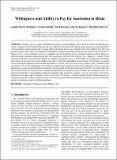Willingness and Ability to Pay for Sanitation in Busia
View/
Publication Date
2019Type
Article, Journalviews
downloads
Metadata
Show full item recordCitation
Josphat Martin Muchangi , George Kimathi , Sarah Karanja , Maarten Kuijpers , Marjolein Ooijevaar , Willingness and Ability to Pay for Sanitation in Busia, Public Health Research, Vol. 9 No. 1, 2019, pp. 7-12. doi: 10.5923/j.phr.20190901.02
Abstract/
Globally, access to improved sanitation remains a major challenge where about 2.4 billion people still lack toilets. Countries in Sub-Saharan Africa are the worst affected where about 800 million people still practice open defecation with remarkable negative health and economic effects. Diarrhoea due to poor sanitation kills more children than HIV and measles together. This study was designed to determine the willingness and ability to pay for safe sanitation by households in Busia County. A cross sectional survey was conducted on 784 households using contingent valuation method. Data was collected using structured questionnaires and both descriptive and inferential statistics were deduced. A model fit and economic modelling was performed to determine willingness and ability to pay. A total of 465(59.4%) male and 319(40.6%) were female heads were interviewed. Slightly more than a half of the respondents earned between 10-50 dollars in a month with no significant difference between male and female (P=0.924). About 487 (63%) were willing to take a sanitation loan and about 67.7% of the respondents were willing to upgrade their sanitation system. The willingness to take a loan and upgrade the existing sanitation differed significantly between male and female respondents (P=0.000). The study finds that dissatisfaction with the existing sanitation significantly affected the willingness to pay (P=0.000). The willingness to pay was high with about 68% of the population expressing interest to take a loan for sanitation. However, only about 10.1% of the population were able to pay for sanitation at the cut off price of 415 dollars. The study concludes that the market potential for sanitation is huge. We further recognize the role of various sanitation financing instruments including loans as the sustainable means of promoting access to improved sanitation.
Further Details
Copyright © 2019 The Author(s). Published by Scientific & Academic Publishing. This work is licensed under the Creative Commons Attribution International License (CC BY). http://creativecommons.org/licenses/by/4.0/
Publisher
Scientific & Academic PublishingISSN
Print - 2167-7263; Online - 2167-7247Collections
- General - GEN [367]

